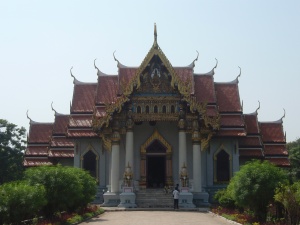Thus far, most places we have visited have beckoned us due to their explanatory power. In our attempt to avoid repetitions, we’ve selected villages, towns and cities which have a unique place on India’s economic, political or socio-cultural map. Benaras, and Uttar Pradesh, were chosen for their ability to augment the religious and political understanding of India.
As soon as we arrived in Benaras, we headed to the Dashashwamedh ghat (bank) to attend the evening Ganga aarti (prayer). This daily ritual, witnessed by hundreds of tourists, is a visual delight that is a mandatory stop for everybody visiting the city. In fact, many tourists are drawn to Benaras by the visuals of this ceremony. The practice captures the often inexplicable religiosity of a majority of Indians who worship a multitude of objects, living beings and geographical features. The Ganges is considered the lifeline of the north as it is credited with lending fertility to the lands of several states before it merges with the Bay of Bengal. However, this knowledge and the mere existence of the water body has become a curse for these states which take the flow of the river for granted and refuse to part with their lands for any activities, thereby not fully exploiting its fecundity.

Preparations for the evening Ganga Aarti
On Diwali day we visited the Kashi Vishwanath temple, considered one of the most sacred spots in the country for Hindus. The compound surrounding the temple also contains a mosque, which is surrounded by barbed wire. The very existence of 2 different places of worship in the same complex is most telling. Not only does it reveal the coexistence of multiple communities in India, it is a comment on the insecurity of a mosque in a post-Babri India. That barbed wires have been erected to prevent another demolition is a worrying reality. The area is heavily guarded by security personnel, who themselves routinely jump queues to enter the temple in order to seek blessings. The line to enter the temple is quite heterogeneous by region, as patrons from across the country throng the site.
We proceeded to taste some Benarasi thandai, a milky concoction of saffron, almonds, peppermint and cream. These stalls are famous for their bhaang (marijuana) thandai. We stuck to the sober version which was quite a delight. We also checked in at a local chaat shop to sample various local delicacies. The tamatar (tomato) chaat is an idiosyncrasy and a must try. Another item not to be missed, which is unique to Benaras is Baati Chokha — a local favorite consisting of a coal baked wheat ball and a mixed vegetable made of potatoes, aubergine, tomato, garlic, onion and mustard oil.

Thandai being prepared

Baati Chokha stalls
To truly explore Benaras you must get hold of a local, preferably with a motorbike as the alleys of the city house its most precious sites and practices. 2 loggers and our host (a local journalist) traversed Benaras on one motorbike — it was a workable exercise in addition to being a visual delight for bystanders. This is how we made our way to India’s biggest and most pious cremation ground. The banks also serve as burning grounds for bodies of the deceased which are brought in large numbers. It is said that the process is perpetual, and the practitioners believe that there is an expressway from this spot to heaven. In order to ensure that none of the souls go to hell, the orchestrators of the last rites pull out the spinal cord of the bodies – while they are burning – and throw them into the river for purification. Apparently, all sins are washed away by the receptacle of all living and non-living things — the Ganges.

Cremation Ground
During our stay in Benaras we visited the Benaras Hindu University, one of Asia’s largest educational institutions. The museum within the campus, Bharat Kala Bhawan, is remarkable as it houses a wide range of artifacts. The curator complained of insufficient funding and as a result, a deficiency of manpower and space. In fact, only 2 per cent of the collection has been displayed. Despite these constraints, the museum has been very well maintained. The University, with ~100 departments, is a wonder in itself.

Library at BHU
To conclude we would like to submit that a part of India’s pulse can be gauged in Benaras. Its narrow streets with countless people, order in that chaos and multiple shades of every color make for the right paraphernalia for one of the world’s oldest cities. It is a confluence of history, religion and spiritualism which questions the simplicity of frameworks usually deployed to understand India.

















